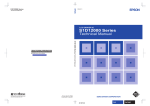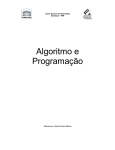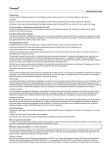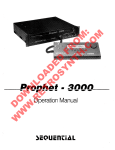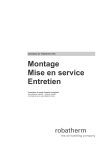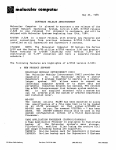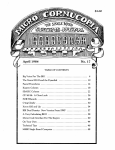Download Qume QVT-102 Installation guide
Transcript
VIASYN Customization Guide Concurrent DOS 8-16 CompuPro CUSTOMIZATION GUIDE FOR CONCURRENT DOS 8-16 CONCURRENT DOS 8-16 CUSTOMIZATION GUIDE Copyright 1985 Viasyn Corporation Hayward, CA 94545 First Edition: February, 1985 Latest Printing: June, 1985 Part No. 8221-0022 Filename: CDOSCUST.MAN DISCLAIMER - Viasyn Corporation makes no representations or warranties with respect to the contents hereof and specifically disclaims any implied warranties of merchantability or fitness for any particular purpose. Further, Viasyn reserves the right to revise this publication and to make any changes from time to time in the content hereof without obligation of Viasyn to notify any person of such revision or changes. Registered trademarks: Televideo, Televideo, Inc. Zenith, Zenith Radio Corporation, CompuPro, Viasyn Corporation. Compound trademarks: Concurrent DOS 8-16 is a compound trademark of Digital Research, Inc. and Viasyn Corporation. Trademarks: Digital Research, Digital Research. Qume, Qume Corporation. All rights reserved. No part of this publication may be reproduced or transmitted in any form, or by any means, without the written permission of Viasyn. Printed and assembled in the United States of America. CONCURRENT DOS 8-16 CUSTOMIZATION GUIDE Copyright 1985 Viasyn Corporation Hayward, CA 94545 First Edition: February, 1985 Latest Printing: June, 1985 Part No. 8221-0022 Filename: CDOSCUST.MAN DISCLAIMER - Viasyn Corporation makes no representations or warranties with respect to the contents hereof and specifically disclaims any implied warranties of merchantability or fitness for any particular purpose. Further, Viasyn reserves the right to revise this publication and to make any changes from time to time in the content hereof without obligation of Viasyn to notify any person of such revision or changes. Registered trademarks: Televideo, Televideo, Inc. Zenith, Zenith Radio Corporation, CompuPro, Viasyn Corporation. Compound trademarks: Concurrent DOS 8-16 is a compound trademark of Digital Research, Inc. and Viasyn Corporation. Trademarks: Digital Research, Digital Research. Qume, Qume Corporation. All rights reserved. No part of this publication may be reproduced or transmitted in any form, or by any means, without the written permission of Viasyn. Printed and assembled in the United States of America. CONTENTS Using This Guide Two Methods for 1 Customization........................................................ 1 XIOS Files Supplied with Concurrent DOS 8-16 1-2 Possible Changes Using DDT86 2-3 Possible Changes with Reassembling 3 Customizing the XIOS Using DDT86 Modifying the Device Tables Saving DDT86 Changes 3-6 6-8 8 Customizing Your Loader Using DDT86 8-10 Customizing Your XIOS by Editing and Reassembling 10 The Source Files 10-11 The GLOBAL.EQU and HEADENTR.A86 Files................................11-12 Editing the GLOBAL.EQU File 12-14 Editing the HEADENTR.A86 File 14-16 Reassembling Your XIOS 16-17 Generating a New System - GENCCPM 18 USING THIS GUIDE This guide is for those of you who have setup Concurrent DOS 8-16 using one of the XIOS files provided, and now wish to customize certain parameters. Customizing should only be done if one of the standard XIOS files does not meet all of the needs of your system. You may also want to customize parameters in the loader you have chosen for your system such as the baud rate of the system console or the step rate of your floppy drives. Note that customization of printer or terminal related characteristics may require changes in the TTYS or LPRS files. Refer to your "Concurrent DOS 8-16 Installation Guide" for information on making changes to the TTYS or LPRS file. TWO METHODS FOR CUSTOMIZATION There are two methods for customizing your operating system. Which one you use depends on the particular changes you want to make. The first method uses DDT86, the Digital Research dynamic debugging tool. DDT86 allows you to interactively change, or "patch", already assembled machine language programs. With Concurrent DOS 8-16 you can use DDT86 to patch the XIOS and the loader files supplied on the distribution diskettes. The second method of customization involves editing certain modules of source code provided by CompuPro on the distribution diskettes. The edited modules are then assembled using RASM86, and linked with already assembled code modules supplied by Digital Research to produce a new XIOS file. When customizing a XIOS file by DDT86 patch or the RASM86 assembler, you must then use GENCCPM to build that XIOS file into a useable CCPM.SYS file. Customizing the loader only requires DDT86 patching. Both DDT86 and RASM86 are explained in more detail in the "Programmer's Utility Guide" found in your Digital Research Concurrent CP/M documentation. GENCCPM is explained in detail in the "System Guide" from Digital Research. XIOS FILES SUPPLIED WITH CONCURRENT DOS 8-16 XIOS stands for extended Input/Output System. The XIOS is a code module that handles the physical interface to Concurrent CP/M and can be modified to handle a variety of specific needs. CompuPro supplies an assortment of assembled XIOS files set up for various different hardware configurations. In addition, CompuPro supplies the source for certain key parts of the XIOS for reassembly and customization. (These files are explained in the section Editing and Reassembling the XIOS.) Your Concurrent DOS 8-16 Installation Guide from CompuPro lists the 14 XIOS files offered on your operating system diskettes. They are repeated here for your convenience. Generic Terminal Files (end in 'G') Generic refers to a terminal with no internal pages of RAM such as a Qume 102. XIOS305G - DISK 3, ST506 5 Mbyte hard disk XIOS320G - DISK 3, 20 Mbyte hard disk XIOS340G - DISK 3, 40 Mbyte hard disk XIOS380G - DISK 3, 80 Mbyte hard disk XIOS220G - DISK 2, 20 Mbyte hard disk XIOS240G - DISK 2, 40 Mbyte hard disk XIOSFLPG - DISK 1 or DISK 1A, floppy only system Televideo Terminal Files (end in 'T') Televideo refers to a terminal with screen switching capabilities identical to those of the Televideo 925/925 or Qume 108. XIOS305T XIOS320T XIOS340T XIOS380T XIOS220T XIOS240T XIOSFLPT - DISK 3, ST506 5 Mbyte hard disk - DISK 3, 20 Mbyte hard disk - DISK 3, 40 Mbyte hard disk - DISK 3, 80 Mbyte hard disk - DISK 2, 20 Mbyte hard disk - DISK 2, 40 Mbyte hard disk - DISK 1 or DISK 1A, floppy only system POSSIBLE CHANGES USING DDT86 The parameters of the XIOS of Concurrent DOS 8-16 that may be changed using DDT86 (Dynamic Debugging Tool) are as follows: * Number of physical consoles (from 1 to 14). * Number of virtual consoles per physical console (from 1 to 4), * Number of list devices (printers, from 0 to 5) . * Number of auxiliary devices (modems, from 0 to 4). * Console baud rate and setup parameters (System Support 1). NOTE: Changing the baud rate of the system console requires the loader and the XIOS to be changed along with the TTYS file. Changing the baud rate of any other terminal requires only the TTYS file to be changed. * Console, list and auxiliary device physical mapping onto the interfacer user ports. * Floppy disk (8" and 5.25") step rates. NOTE: Changing the step rate of a floppy drive requires changes to the XIOS and loaders. * Terminal dependent codes for screen switching. Patches that can be made to the loaders are changes to the baud rate of the system console and the step rate of the floppies on the floppy loaders. Changes to a loader do not require a GENCCPM be done afterward. POSSIBLE CHANGES WITH REASSEMBLING Reassembling the XIOS requires DR ASSEMBLER + TOOLS, an assembler package available from CompuPro but not included with Concurrent DOS 8-16. The parameters of Concurrent DOS 8-16 that may be changed with reassembly of the XIOS include those changes that can be made using DDT86 as well as the following: * Number and type of hard disks supported. * Number of floppy disks supported. -Four 8" floppies -Four 5.25" floppies -Two 8" and two 5.25" floppies * terminal drivers. * DPB's and DPH's for all drives. CUSTOMIZING THE XIOS USING DDT86 DDT86 allows you to make changes to your XIOS file as well as changes to your loader. Changes to the XIOS file must be followed by a GENCCPM in order to generate the new CCPM.SYS file. First, choose the XIOS file you want to customize. Then, create a backup by typing: 0A>PIP XIOS.CON=XIOS????.CON[V] [RET] where XIOS????.CON is the XIOS file you have chosen to use from the above list of XIOS files offered as part of Concurrent DOS 8-16. You are now ready to enter into DDT86. The listings outlined in this guide are applicable to each of the standard XIOS files supplied by CompuPro. A brief description of DDT86 commands will help you understand exactly what DDT is doing. For a more detailed understanding of DDT86, refer to the "Programmer's Utilities Guide" from Digital Research. D - displays memory in hexadecimal and ASCII L - lists memory using assembler mnemonics R - reads a program for subsequent testing S - substitutes memory values X - examines and optionally alters the CPU state W - writes changed file back to disk The DDT86 prompt for you to enter your commands is '-'. In the following instructions, the commands listed after the DDT86 prompt '-', indicate the commands you should type in. The characters to be input at the keyboard by you are underlined. Enter into DDT86 by typing: OA>DDT86 [RET] At the '-' prompt, you may begin your entries as follows: DDT86 1.2 -rXIOS.CON START END XXXX:YYYY XXXX:0000 -xcs CS 0000 zzzz (ZZZZ=XXXX + 0008, this value should be DS 0 0 0 0 zzzz placed in the CS and DS registers to SS WXYZ initialize them for the correct segments.) -s0C10 (Typing "s0C10" starts listing the locations and contents of values which determine the number of consoles and printers. It also puts the operator into the substitute mode. Type a carriage return at a line to leave the contents there unchanged; type a new value and a carriage return to replace the value shown. All values are in hex.) ZZZZ.:0C10 07 ZZZZ:0C11 0E (This is the number of physical consoles; values from 01 to OE.) (This is the total number of virtual consoles. The value equals virtual consoles per individual physical console multiplied by the number of physical consoles; values from 01 to 3C.) ZZZZ.:0C12 0E (Total console control blocks; same as virtual consoles.) ZZZZ:0C13 02 (This is the number of list devices; values from 0 to 5. This value indicates how many significant entries there are in the list device table starting at address 0C50.) ZZZZ:0C14 00 A period ends the listing of locations in the substitute mode and returns you to the DDT86 prompt. -s0C3A (Typing "s0C3A" puts you in the substitute mode at the locations of the 8" and 5" floppy disk step rates.) ZZZZ:0C3A CF (8" floppy disk step rate; Values DF=3 ms., 8F=8 ms.) ZZZZ:0C3B 46 (a return will enter the default value) ZZZZ:0C3C DF (5.25" floppy disk step rate; Values are the same as 8" disks) ZZZZ:0C3D 1E (enter default value) (The locations of the SYSTEM SUPPORT I initialization bytes follow.) ZZZZ:0C3E EE ZZZZ:0C3F 7E ZZZZ:0C40 27 (System Support 1, USART mode register 1) (System Support 1, USART mode register 2, includes baud rate value) (System Support 1, USART command register) (The locations of the I/O CONSOLE TABLE follow. Instructions on modification of this table are given below.) ZZZZ:0C41 00 ZZZZ:0C42 08 ZZZZ:0C43 07 ZZZZ:0C44 04 ZZZZ:0C45 03 ZZZZ:0C46 02 ZZZZ:0C47 01 ZZZZ:0C48 0A. ZZZZ:0C49 0B ZZZZ:0C4A 0C ZZZZ:0C4B 0D ZZZZ:0C4C 0E ZZZZ:0C4D 0F ZZZZ:0C4E 10 (Console 0, System Support 1) (Console 1, Interfacer 3/4, User 7 (8-1=7)) (Console 2, Interfacer 3/4, User 6 (7-1=6)) (Console 3, Interfacer 3/4) (Console 4, Interfacer 3/4) (Console 5, Interfacer 3/4) (Console 6, Interfacer 3/4) (Console 7, Second Interfacer 3/4, User 09 (0A1=09)) (Console 8, Second Interfacer 3/4, User 10) (Console 9, Second Interfacer 3/4, User 11) (Console 10, Second Interfacer 3/4, User 12) (Console 11, Second Interfacer 3/4, User 13) (Console 12, Second Interfacer 3/4, User 14) (Console 13, Second Interfacer 3/4, User 15) (The locations of the LIST DEVICE TABLE follow. Instructions on modification of this table are given below.) ZZZZ:0C4F 05 ZZZZ:0C50 06 ZZZZ:0C51 09 ZZZZ:0C52 00 ZZZZ:0C53 00 (Printer 0, Interfacer 3/4, User 4) (Printer 1, Interfacer 3/4, User 5) (Printer 2, Interfacer 3/4, User 8; Note that this is the third entry of the LIST DEVICE TABLE, and even though it is set up for USART 09, it will only be significant at boot time if the value determining the number of printers [location 0C13] is three or greater.) (Printer 3) (Printer 4) (The locations of the AUX DEVICE TABLE follow. Instructions on modifications of this table are given below.) ZZZZ:0C54 00 ZZZZ:0C55 00 ZZZZ:0C56 00 ZZZZ:0C57 00 ZZZZ:0C58 00 (Aux 0) (Aux 1) (Aux 2) (Aux 3) (Number of auxiliary devices; Value from 0 to 3) (Finally, at locations 0C5E to 0C60 are values which relate to the virtual console characteristics of the terminal drivers.) ZZZZ:0C5E 02 ZZZZ:0C5F 01 ZZZZ:0C60 30 (Number of virtual consoles per physical consoles; Value 1 to 4) (Above value minus 1) (Value of the first page of memory in the terminal; ex: 108, 925, 950, etc.; this value is FF with a generic 'G' XIOS file or a Televideo 'T' XIOS file) Modifying the Device Tables Each of the three tables shown above are are limited in effect by a byte value. The I/O CONSOLE TABLE has a total of thirteen entries, but only as many entries as there are PHYSICAL CONSOLES (as designated by the constant at location 0C10) will be read in by the system at boot time. The LIST DEVICE TABLE has a total of five entries, but only as many entries as there are LIST DEVICES (as designated by the constant at location 0C13) will be read in by the system at boot time. The AUX DEVICE TABLE has a total of four entries, but only as many entries as there are AUX DEVICES (as designated by the constant at location 0C58) will be read in at boot time. Each of the entries in these tables contain hex values corresponding to USARTs assigned to the that entry's device. The USART numbers are mapped to the actual physical I/O boards in the manner illustrated in TABLE # 1. TABLE #1: MAPPING OF USART NUMBERS TO ACTUAL I/O DEVICES PCON NUMBER 0 1 2 3 4 5 6 8 9 A B C D E I/O BOARD RELATIVE USER SYSTEM SUPPORT I INTERFACER 3/4 INTERFACER 3/4 INTERFACER 3/4 INTERFACER 3/4 INTERFACER 3/4 INTERFACER 3/4 INTERFACER 3/4 2nd INTERFACER 3/4 2nd INTERFACER 3/4 2nd INTERFACER 3/4 2nd INTERFACER 3/4 2nd INTERFACER 3/4 2nd INTERFACER 3/4 7 6 3 2 1 0 9 10 11 12 13 14 15 In the software as supplied by CompuPro the tables are set up for fourteen consoles and three printers using a SYSTEM SUPPORT I and two INTERFACER 3s. The number of PHYSICAL CONSOLE DEVICES is set for seven, and the number of LIST DEVICES is set for two; these values are the maximum possible for systems with only one INTERFACER 3 (the average system). So for most systems, to add another printer, you would either have to add another INTERFACER 3 OR 4 or rearrange a USART assignment from the I/O CONSOLE TABLE to the LIST DEVICE TABLE. In either case, you would have to adjust the device constants accordingly. For example, if you want to add a third printer on your system, but you only have one INTERFACER 3, you have to decrease your total of consoles from seven to six. You could remove console 6 by replacing the 01 (USART 01) at location 0C47 with the 0A from location 0C48 below it, and moving each entry in the table up one (0B where 0A was, 0C where 0B was, etc.) until you get to the last CONSOLE DEVICE entry (0C4E) which would be set to 00. Then you could reassign that USART 01 to the third entry in the LIST DEVICE TABLE (0C51). Finally you would decrease the PHYSICAL CONSOLES constant (0C10) from 07 to 06, and increase the LIST DEVICES constant (0C13) from 02 to 03. If you changed the table in this way it would look like this: ZZZZ:0C44 ZZZZ:0C45 ZZZZ:0C46 ZZZZ:0C47 ZZZZ:0C48 ZZZZ:0C49 ZZZZ:0C4A ZZZZ:0C4B ZZZZ:0C4C ZZZZ:0C4D ZZZZ:0C4E ZZZZ:0C4F ZZZZ:0C50 ZZZZ:0C51 00 08 07 04 03 02 01 0A 0B 0C 0D 0E 0F 10 05 06 09 ZZZZ:0C52 00 ZZZZ:0C41 ZZZZ:0C42 ZZZZ:0C43 — — — — — — 0A 0B 0C 0D 0E 0F 10 00 --01 (reassign USART 0A as console 06) (move up rest of entries) (set the last entry of the table to 00) (Printer 0, first entry in list table) (Printer 1, second entry in list table) (replace USART 09 with USART 01 in third entry of the LIST DEVICE TABLE, printer 2) Changing the assignment of AUX DEVICES can be accomplished in the same manner: reassign the USARTs in the I/O CONSOLE TABLE, assign a free USART to the AUX DEVICE TABLE, and change the PHYSICAL CONSOLE and AUX DEVICE constants accordingly. Saving DDT86 Changes To save changes in DDT86, end the address listing with a period. At the next '-', type the command 'W' followed by the file name on the same line and all changes made in DDT86 will then be saved. -WXIOS.CON (This will save your changes to the XIOS file) To exit from DDT86, press a control C. Be sure you have saved your changes before exiting. It is also a good practice to save your XIOS file to another drive under a different file name to be sure you always have a safe copy of your changes. Remember, any changes to the XIOS must be followed by a GENCCPM in order to generate a new CCPM.SYS file. GENCCPM is explained later in this manual. CUSTOMIZING YOUR LOADER USING DDT86 You may also make changes to your loader file using DDT86. First, load the loader file you are using into DDT86. The loader files offered are listed in your "Concurrent DOS 8-16 Installation Guide". To read your loader into DDT86, type: 0A>DDT86 [RET] After a quick sign-on, you will be given the DDT86 prompt '-'. Type 'R' to read in a file followed by the name of your loader file. For example, to work on the loader file for a system using 8" floppies with a CPU 8085/88, type "RLDRCCPM8.88": -RLDRCCPM8.88 START END 8400:0000 8400:1F7F (Listing locations 153F to 1542 will reveal two 16-bit pointers, one used to compute the locations for the initialization bytes for the console I/O and the other used to compute the locations for the step rate for the boot floppy. The pointers may change, but they will always be at these locations.) -S153F 8400:153F A9 8400:1540 19 8400:1541 88 8400:1542 1A 8400:1543 81 -- (This pointer, 19A9, is added to -- the location of the console I/O -- (This pointer, 1A88, is added to -- the location of the floppy step 369H to compute init. bytes.) 300H to compute rate.) (The DDT86 "H" command can be used to add the offset of 369H.) -H19A9,369 1D12 1641 (1D12 is the effective address.) (Use the substitute mode to display the console I/O init. bytes. A thorough explanation of these bytes is available in the SYSTEM SUPPORT I technical manual. Type "s1D12".) -S1D12 8400:1D12 5E 8400:1D13 5A 8400:1D14 5E 8400:1D15 7E 8400:1D16 5F 8400:1D17 27 8400:1D18 57 (SYSTEM SUPPORT 1 I/O port address.) (mode register 1 init. byte) (port address) (mode register 2 init. byte; 7E for baud rate of 9600, 7F for 19.2K) (port address) (command byte) (Use the "H" command again to add 1A88 and 300) -H1A88,300 1D88 1788 (1D88 is the effective address.) (List the step rate byte in the substitute mode; type "slD88".) -sD188 8400:1D88 CF -- (Step rate byte for boot floppy, either 8" or 5.25". In this byte, the first nibble determines the step rate. A value of FF is for a step rate of 1 ms., EF for 2 ms., DF for 3 ms., CF for 4 ms. and so on to OF for 16 ms.) 8400:1D89 . (This concludes the loader changes you can make using DDT86. Any changes can be saved by typing "w" followed by the name of the file to which you wish to save the results. To save the changes in file "LDRNEW.88" type "wLDRNEW.88":) -wLDRNEW.88 This completes the changes you may make to the parameters of the XIOS file and LOADER.CMD file using DDT86. CUSTOMIZING YOUR XIOS BY EDITING AND REASSEMBLING You can customize much of the characteristics of the Concurrent DOS 8-16 operating system by editing source code, assembling it, linking it with other assembled code modules, and building it into a CCPM.SYS file using the GENCCPM program. This section explains what source code is supplied with Concurrent DOS 8-16, how to edit it, and how to reassemble and link it. All of the following changes require reassembling your XIOS with DR Assembler + Tools, an assembler package not included with Concurrent DOS 8-16 but available from CompuPro. The Source Files Four source files are supplied with the Concurrent DOS 8-16 distribution diskettes: HEADENTR.A86, GLOBAL.EQU, DPBS.EQU, and DPBS.A86. Two other files are included by assembler directives in the assembly of HEADENTR.A86 and must be present on the working disk when the assembly process begins. These files are SYSTEM.LIB and SYSDAT.LIB. A brief definition of each of these files follows: HEADENTR.A86 - This file contains the Concurrent CP/M XIOS entry points and header block, terminal specific codes, floppy disk specify bytes, and character I/O device mapping tables. SYSTEM.LIB General system equates that have been defined by Digital Research and are not subject to change. SYSDAT.LIB Digital Research defined equates not subject to change. GLOBAL.EQU General system configuration equates that may be changed to accomodate changes involving hard disks, terminals, etc. DPBS.EQU General equates applied to DPB's (Disk Parameter Block) and DPH's (Disk Parameter Header) generation. Instructions on modifying this file are not available from CompuPro. DPBS.A86 DPB and DPH data. Instructions on modifying this file are not available from CompuPro. Note that while the files DPBS.EQU and DPBS.A86 are included on the distribution diskettes, CompuPro does not support modifications to them through this document or any other. They are included so that experienced systems level assembly language programmers may undertake to modify the characteristics of the logical drives which CompuPro supports (e.g. logical drive size) or even to support drives available from sources other than CompuPro. Documentation on the data structures involved in these files can be found in the Digital Research Concurrent CP/M-86 System Guide included with Concurrent DOS 8-16. The files explained here are HEADENTR.A86 and GLOBAL.EQU. The GLOBAL.EQU and HEADENTR.A86 Files Both the GLOBAL.EQU file and the HEADENTR.A86 file contain many specific values you may want to change to better adapt your operating system to your needs. Table #2 illustrates the changes that can be made to the HEADENTR.A86 and GLOBAL.EQU files. TABLE #2: GLOBAL.EQU AND HEADENTR.A86 POSSIBLE CHANGES POSSIBLE CHANGES GLOBAL.EQU HEADENTR.A86 5.25" Floppy Disk Equates Yes No Floppy Disk Specify Bytes - 5.25" Floppy Disk Specify Bytes - 8" No No Yes Yes Hard Disk Equates - DISK 2 Hard Disk Equates - DISK 3 Yes Yes No No Console Configuration Equates* -# of physical consoles (Pcon) -# of Vcons per Pcon -# of list devices -type of console (e.g. QUME 102) Yes No Mapping Tables for Character I/O Devices* -Consoles -List devices -Auxiliary devices -# of Aux devices No Yes System Support Initialization No Yes Terminal Specific Driver Tables No Yes Yes No Console Screen Buffering Equates (as required for a Zenith Z-19) *Any changes to the console, list device (printer), or auxiliary device mapping must be reflected in the GLOBAL.EQU, HEADENTR.A86, TTYS, and LPRS files. Console and list device mapping may also be patched through DDT86 as shown in the previous section of this manual. Editing the GLOBAL.EQU File There are five basic areas where you may need to make changes to the GLOBAL.EQU file: 1. 2. 3. 4. 5. 5.25" floppy disk drive equates Hard disk equates Console configuration equates PC Graphics Board equates Console screen buffering equates Here are explanations of all of the pertinent equates in the order in which they appear. FLOPPY5 - Set True if you have 5.25" drives; False if you do not have 5.25" drives. HEADS5 - Set to the number of heads of your 5.25" drives. to 2 for CompuPro 5.25" drives. TRK5 - Set to the number of tracks of your 5.25" floppy. Set to 80 for CompuPro 5.25" drives. Set FLPYORDR - Set to 0 if physical drive 0 should be the "A8" drive in a floppy only system. Set to 2 if physical drive 2 should be the "A8" drive in a floppy only system, i.e. 5.25" drives. (Only values 0 and 2 are valid. Has no effect on hard disks systems.) DISK2 - Set to true if a DISK 2 is present. (Set to false if a Disk3 is present.) DISK3 - Set to true if a DISK 3 is present. (Set to false if a DISK 2 is present.) D2M20 - Set to true when using 20 Mbyte Fujitsu HD. D2F40b - Set to true when using 40 Mbyte Fujitsu HD. D3ST506 - Set to true when using 5 Mbyte ST506 HD. D3Q520 - Set to true when using a 20 Mbyte Quantum HD. D3Q540 - Set to true when using a 40 Mbyte Quantum HD. D3Q80 - Set to true when using an 80 Mbyte Quantum HD. NPCONS - Number of physical consoles. VCOFF - Number of virtual consoles per physical console. NLST - Number of list devices. Z19 - Set to true if terminal type is Zenith Z-19. Only one terminal can be set to true. The Zenith Z-19 is a terminal without RAM paging capability for which Digital Research has included drivers which emulate the RAM paging in main memory. These drivers consist mostly of equates which correspond to the terminal's control codes. CompuPro includes them with the distribution diskettes as an example for those who wish to support screen switching on other terminals which do not have RAM paging capability. CompuPro will not assist in supporting terminals other than those mentioned in this document. TELEVIDEO- Set to true if terminal type is Televideo 925 or Qume QVT-108. QUME102 - Set to true if terminal type is Qume QVT-102. The QVT102 is also a terminal without RAM paging capability. CompuPro has not implemented buffered console screen switching for this terminal, but it has implemented code which does a clear screen and homes the cursor after a screen switch. PCBRD - Indicates presence of PC Graphics Board. Set to false unless PC Graphics Board documentation indicates otherwise. CONBUFF - This is a value indicating how much memory to allot for a console screen buffer. It is only significant if the Z-19 equate is true or if you are developing console buffering for a terminal other than those supported by ComnpuPro. Any equates in GLOBAL.EQU that are not explained above are not intended for change by CompuPro at this time. Editing the HEADENTR.A86 File There are four basic areas which you might need to change in the HEADENTR.A86 file: 1. 2. 3. 4. Floppy disk specify bytes SYSTEM SUPPORT I I/O port reinitialization string I/O character device mapping tables Terminal definition tables These areas are explained below: 1. The floppy disk specify bytes are equates which determine the step rate for both 5.25" and 8" floppy disks. Here are explanations of the equates: SRT8 - 8" floppy drive step rate. Set to "16 - 4" by VIASYN for a step rate of 4 ms. The number subtracted from 16 is equal to the resultant step rate. SRT5 - 5" floppy drive step rate. Set to "16 - 3" by CompuPro for a step rate of 3 ms. Same formula as for SRT8. 2. The SYSTEM SUPPORT I is first initialized by the loader and then reinitialization by the XIOS. The bytes for the second initialization are represented in binary form on the fourth page of the HEADENTR.A86 file. The programming comments in the code explain clearly the functions of the bytes. For information on how the bytes can be changed, consult the SYSTEM SUPPORT I Technical Manual. 3. There are three character device tables: CONTABLE for I/O consoles, LSTABLE for list devices, and AUXTBL for auxiliary devices. They are shown below: NOTE: System Support 1 should always be the first console. CONTABLE DB 0,8,7,4,3,2,1,10,11,12,13,14,15,16 LSTABLE DB 5,6,9,0,0 AUXTBL DB 0,0,0,0 AUXNUM DB 0 The numbers in these tables are USART numbers as explained in TABLE #1 in this manual. In CONTABLE, there are fourteen entries corresponding to consoles 0 to 13 counting from left to right. This assumes that there are two INTERFACER 3s in the system. In LSTABLE, there are five entries corresponding to printers 0 to 4. The third entry in LSTABLE assumes that there are two INTERFACER 3's in the system. The last two entries in LSTABLE are zero meaning no USART is assigned to them. In AUXTBL there are four entries corresponding to auxiliary devices 0 to 3. All entries in AUXTBL are zero meaning no USARTs are assigned for auxiliary devices. All of these tables are limited by a constant elsewhere in the code. If the constant for number of physical consoles (NPCONS in the GLOBAL.EQU file) is set to 07, then only the first seven entries in CONTABLE are read in at boot time. The remaining entries are insignificant. LSTABLE is limited by NLST in the GLOBAL.EQU file, and AUXTBL is limited by AUXNUM here in the HEADENTR.A86 file. To reassign USARTs in these tables to support a different combination of character devices: A. Remove the appropriate USART number from one table. B. Move the remaining entries in the table over to the left to fill in the gap left by the removal in step 1. C. Enter a zero at the now empty last entry on the table. D. Enter the USART number into the first free entry, or in place of an entry that is not significant, in the table for the devices you wish to increase. E. Make sure that the values NPCONS, NLST, and AUXNUM are all updated to reflect the new table configuration. For example, if we want to remove console 6 and add printer 3 in its place, and if our system has only one INTERFACER 3, the new table would look like this: CONTABLE DB 0,8,7,4,3,2,10,11,12,13,14,15,16,0 LSTABLE DB 5,6,1,0,0 AUXTBL DB 0,0,0,0 4. There are three terminal definition tables in the HEADENTR.A86 file: one for Televideo 925 or Qume QVT-108 terminals, one for QUME QVT-102 terminals, and one for Zenith Z19 terminals. These tables contain constants related to terminal control characters that are used when a screen switch is requested by the user. They are supplied by CompuPro as examples to assist programmers developing drivers for terminals other than those which CompuPro supports. No further support for other terminals is available from CompuPro. The remaining constants in HEADENTR.A86 are defined by CompuPro and should not be changed. Reassembling Your XIOS STEP 1. To assemble the new HEADENTR.A86 file with the new GLOBAL.EQU equates, type: 0A>RASM86 HEADENTR $PZSZLO [RET] $PZSZLO - The CompuPro recommended parameters for reassembly. (Consult your Digital Research documentation for details.) This produces the file HEADENTR.OBJ STEP 2. Pick the hard disk file appropriate to your system and rename it HDISK.OBJ by typing: 0A>PIP HDISK.OBJ=HDISK?.OBJ[VROW] where HDISK?.OBJ = HDISK240.OBJ = HDISK220.OBJ = HDISK3.OBJ = HDISKNHD.OBJ - [RET] for DISK 2, 40 Mbytes for DISK 2, 20 Mbytes for DISK 3, any size for systems with no hard disk HDISK.OBJ is a file containing the assembled but not linked hard disk support code. STEP 3. Pick the appropriate file for the PC Video board by typing: 0A>PIP VSCPG.OBJ=VSC???.OBJ[VROW] [RET] where VSC???.OBJ is VSCNPC.OBJ - for a system without a PC Video board; and VSC???.OBJ is VSCYPC.OBJ - for a system with a PC Video board. VSCPC.OBJ is the file containing the assembled but not linked PC Video card code. STEP 4. Pick the appropriate serial terminal driver file by typing: 0A>PIP VSCREEN.OBJ=VSC???.OBJ[VROW] [RET] where VSC???.OBJ is VSCREENG.OBJ - for most types of terminals; and VSC???.OBJ is VSCZ19.OBJ - for Zenith Z19 terminals. VSCREEN.OBJ is the file containing the assembled but not linked terminal dependent screen drivers. STEP 5. The object files you've just created and others must now be linked together. The necessary files are: HEADENTR.OBJ INITENT.OBJ INTVEC.OBJ PIC.OBJ CTC.OBJ TICK.OBJ NP8087.OBJ CONOUT.OBJ SEROUT.OBJ VSCREEN.OBJ CONIN.OBJ SERIN.OBJ SSINT.OBJ I3INT.OBJ SERVAR.OBJ LIST.OBJ SWITCH.OBJ STATLIN.OBJ VCCB.OBJ SERDATA.OBJ FUNC56.OBJ VSCPC.OBJ DENTRY.OBJ RESKEW.OBJ MDISK.OBJ FD.OBJ PCMODE.OBJ CPROXIOS.INP HDISK PCKEY To link all the object files together, type: 0A>LINK86 CPROXIOS[I] [RET] NOTE: Depending on the version of LINK86, you may get undefined symbols dealing with the 8087. This is because some versions of LINK86 do not support 8087 references. These will have no effect on the final result. STEP 6. The resulting command file, CPROXIOS.CMD, must be renamed by typing: 0A>REN XIOS.CON=CPROXIOS.CMD [RET] This completes the changes you may make to your XIOS. After making any changes to your XIOS, you must run a GENCCPM in order to generate a new system that incoroporates these changes. GENERATING A NEW SYSTEM - GENCCPM In order to build a CCPM.SYS file we will need to run the GENCCPM program. The necessary files are: SUP.CON MEM.CON PIN.RSP VOUT.RSP STATLINE.RSP* SYSDAT.CON XIOS.CON CIO.CON BDOS.CON RTM.CON SHELL.RSP or SHELL.NPC (only one)** ABORT.RSP * STATLINE.RSP replaces CLOCK.RSP in the Digital Research documentation. ** SHELL.RSP includes the PC module; SHELL.NPC does not include the PC module. You may also want to include DIR.RSP. This will allow you to run DIR without loading it from the disk. However, do not include DIR.RSP in systems that will use the network. DIR.RSP does not operate properly on the network. Your Concurrent DOS 8-16 diskettes include an input file called COMPUPRO.IN to be used when doing a GENCCPM. The input file allows you to input the system generation commands for a GENCCPM. In the programmer's section of your Digital Research documentation, the System Guide gives an explanation of GENCCPM input files. Review this section to familiarize yourself with input files. To run the GENCCPM program with the input file, type: 0A>GENCCPM <COMPUPRO.IN [RET] The screen will rapidly scroll several pages of output and then stop with a MENU. At this point, type: GENSYS The GENCCPM program will complete the building of a new CCPM.SYS file. After running a GENCCPM, reassembly of the XIOS is completed. You now have a custom CCPM.SYS file and your customization is complete.























